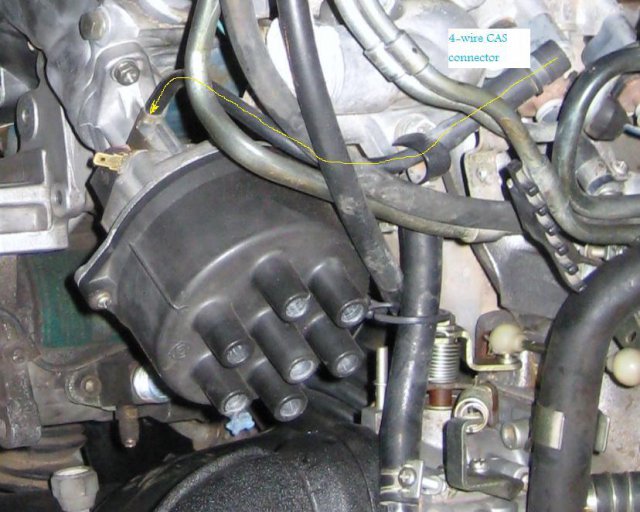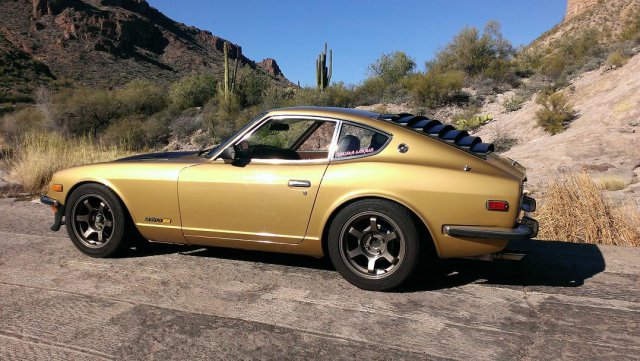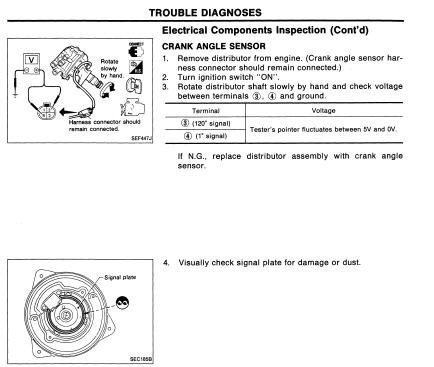-
Posts
672 -
Joined
-
Last visited
-
Days Won
8
Content Type
Profiles
Forums
Blogs
Events
Gallery
Downloads
Store
Everything posted by cgsheen
-
The exterior door handle is broken. Easy to see once you remove the 2 nuts holding it in and remove it. The "arm" that moves the rod with the white plastic "nut" at the bottom is broken off. Look at it closely, but to me it looks as if it's broken at the "pivot" so it's always going to be sloppy (not connected correctly) on that side of the handle. That's what's making that handle look "wrong" when you lift it up. Not that the left side comes out too far - the right side moves IN because of the broken pivot. New handle time...
-
There weren't all that many stock colors available. Look around the spare tire well for the orignal color and match it to the tables listed above. (Even if the car were re-painted at some point (and most Z's have been) hardly anyone takes the time and effort required to completely remove or overspray EVERY inch of factory paint. There's usually a trace on something - under carpet, under trim panels, usually around the edges of the spare tire well...)
-

L28et swap RICH in the >10 AFR's, AFM at idle?
cgsheen replied to SDgoods's topic in Trouble Shooting / General Engine
Yes, you can use the '82-'83 CAS with an '81 ECU. It doesn't know the difference. The same signal is coming from both types of CAS. I used an '81 ECU and harness on my '83 L28ET for years before swapping to VG30E engine management... -

L28et swap RICH in the >10 AFR's, AFM at idle?
cgsheen replied to SDgoods's topic in Trouble Shooting / General Engine
In the picture, It's the '82-'83 turbo distributor WITH the stock wiring. Normally, when you buy that distributor, it'll have that wiring attached (since it doesn't work without it!). Only an a-hole would sell a guy a '82-'83 turbo distributor without that connector intact... -

L28et swap RICH in the >10 AFR's, AFM at idle?
cgsheen replied to SDgoods's topic in Trouble Shooting / General Engine
Not the best picture, but this is what the '82-'83 Turbo Distributor looks like. It has a 4-pin (spade) plug covered (normally) with a black rubber weather seal, and a bracket which is bolted to the dist. to hold it in place. The wire is 10 to 12 inches long and connects to the ECCS harness just behind the thermostat - same connector that the external CAS uses... If you unscrew the distributor cap and remove the rotor, you should see a metal plate covering the stainless steel optical wheel and the electronics that make it all work. If you actually have a turbo dizzy, you need to get that thing hooked up! You'll need the connector though. If you don't have it, it may be tough to find another... HowlerMonkey put an L28ET in his F31. I put F31 engine management on my L28ET... -

L28et swap RICH in the >10 AFR's, AFM at idle?
cgsheen replied to SDgoods's topic in Trouble Shooting / General Engine
-
-

L28et swap RICH in the >10 AFR's, AFM at idle?
cgsheen replied to SDgoods's topic in Trouble Shooting / General Engine
Oh, we're talking two different things. The Air Regulator is a completely seperate device. The A.A.C. does not get it's air supply from the Air Regulator. The FSM describes the A.A.C and it's function in depth. The Air Reg. is supplied voltage by the fuel pump relay. It has a bi-metal "arm" inside that moves a shutter. It's wrapped with a coil, and when power is applied it heats the bi-metal which slowly bends. As it bends, it moves the shutter. As I recall, the shutter is open when the engine is cold to supply by-pass air and raise idle speed, then closes within a couple of minutes. And, you're right, neither of these should be the cause of your overly Rich condition. The L28ET relies on it's "base map" a great deal. It will only poll the O2 Sensor if it can get into "closed loop" mode. It will only try to get into "closed loop" mode under certain conditions - above a certain RPM, below a certain RPM, when the CHTS is above a certain temperature, and if it's getting proper signal from it's other sensors... All that stuff is outlined in the FSM and it's mostly "all sensors working, warmed up, and at cruising speed". At idle it doesn't poll the O2 Sensor, over 3500 RPM or under heavy load, it doesn't poll the O2 Sensor. You know when it's in closed loop mode because the LED on the side of the ECU will start flashing. The ECU is then polling the O2 Sensor and trying to pulse the injectors so it runs just on the edge of just Rich and just Lean and the LED is signaling the change being reported by the O2 Sensor. I don't think a downpipe leak would skew the O2 Sensor reading. It's still a pressurized pipe and most of the exhaust gases are still going down the pipe past the sensor(s). It's oxygen content is not going to change because some of the exhaust gases are going out a different hole. Because it's pressurized, no external air is going to get in there and change the composition of the exhaust gases. -

L28et swap RICH in the >10 AFR's, AFM at idle?
cgsheen replied to SDgoods's topic in Trouble Shooting / General Engine
The Interweb says 20 inches hg = 9.8 PSI, so ya, at 20 inches hg vacuum the fuel pressure should be about 26 PSI... I'll have to look at the FSM again I guess... I have in my mind the A.A.C. is directly controlled by the VCM, which is directly controlled by the ECU (as is the Fuel pump relay - doesn't matter if there's an aftermarket fuel pump, you still want it controlled by the ECU through the fuel pump relay I would think. You may not want the fuel pump modulator...) -
I have an early 260. Just a few months ago I pulled the entire heating & A/C system out of a '75 280 - they're the same - so is a '76...
-

L28et swap RICH in the >10 AFR's, AFM at idle?
cgsheen replied to SDgoods's topic in Trouble Shooting / General Engine
Not to niggle, but - everyone seems to refer to fuel pressure as a static figure. It's really not. The FPR is supposed to maintain a 36.3 PSI (250.1 kPa, 2.55 kg/cm squared) differential between fuel pressure and manifold pressure. That means you subtract the manifold vacuum or add the boost pressure to get the proper fuel pressure required at any given time. How much vacuum are you running at idle? Subtract that from 36.3 to see what your fuel pressure should read... -

L28et swap RICH in the >10 AFR's, AFM at idle?
cgsheen replied to SDgoods's topic in Trouble Shooting / General Engine
On the stock ECCS, a non-working A.A.C. will definately cause a Rich condition - it needs that bypass air at idle. We noticed that on my Son's L28ET swap. It ran Rich by a couple of points (was in the mid-12's at idle). Connecting a vacuum supply brought it back into the 14's. His VCM was disconnected and he needed it to pass emissions at idle, so we just hard-wired it to vacuum... Doesn't sound like that's your whole problem, but it may help. On mine, I don't need no stinking A.A.C. -
Lots more info needed... You didn't mention which fusible link starts to smoke (ya, not a good sign...) Your 280 has 4 of it's own and you should have added at least one more with the swap. The ECCS ECU has 2 power sources, one connected through a fusable link directly to the battery and one from the EFI Relay which is activated by the IGN switch. Easy to see when you have the FSM in hand and you're looking at the turbo circuit diagram...
-
Yup, "Polar Pop" in the ashtray...
-

1983 280zx turbo runs better with chts unplugged
cgsheen replied to k204drek's topic in Trouble Shooting / General Engine
(You knew you were going to get this one...) Then, something else is wrong. The Factory Service Manual shows you how to test every component in the ECCS system on the L28ET. The tests aren't hard and don't require special electronics. All you need is a Harbor Freight Multimeter (and a little patience)... Don't forget to check vacuum and intake leaks. Most important - wiring and electrical connectors on the harness. Make sure the wiring and connections are good from every part and / or sensor all the way to the ECU. Double check all the ECU socket connectors and pins. Clean and de-ozidize everything - then do it again... Don't discount the possibility that someone in the past made other "adjustments" to that system to make it run - rather than finding the actual problem and repairing it... And, most of all, HAVE FUN! -
Ya, happened to me too. I blocked that site. Now the page formatting of this site is all fouled up. Someone got to it I guess...
-

260z L28et Build (first build newb)
cgsheen replied to Co0ke's topic in S30 Series - 240z, 260z, 280z
That's why the "learn" is in quotes. And, I'm using an Infiniti M30 (F31) ECU & related equipment. Heated O2 sensor and the ECU is pretty much "up to speed" as soon as the sensor is warmed up. Takes seconds. With my wideband, the AFR is on target just as soon as the heater cycle is finished. Stock ECU doesn't even start "polling" the O2 sensor until the CHTS reaches a certain temp and can't keep idle AFR without a working AAC. The M30 ECU can keep my idle AFR on track without the AAC. Personally, I'm not really sold on the Z31 ECU... The '90's Infiniti or Maxima is what I look at. Seems like they always put more tech in the Infiniti's though. Co0ke: You don't need a turbo ECU to run stock. You'll need a tunable ECU to go much past that. -
Any distributor-type VG. If you look closely at your dist. you'll see that the optical module sits in the bottom held in by 3 screws. If you remove the "chopper wheel" and it's mounting hardware from the shaft, you'll see. You'll use all you old parts other than the optical module. While it's out, check your chopper wheel closely and make sure it's clean - all the slits in the wheel. (the VG chopper wheel will be slightly different than yours - keep it (so you'll already have it when you get tired of the stock engine management and swap to a VG30e ECU & MAF!)) Your optical module will be "bare" on top - you'll see the electronic components covered with thick protective coating. The newer module will probably have a plastic case over the top and maybe a stainless steel shield. Doesn't matter, will still fit... I have both types and an L28ET sitting in the back of the shop - maybe I can get some pics.
-
Heroe, just remembered something that happened to my CAS: I had an issue with my L28ET just shutting down (driving, the engine would just quit...) At first it would start right back up - as the problem progressed, it would have to sit (maybe cool off a bit) for a while before it would restart. I ran through everything with no luck (coil, ignitor, ECU, wiring). THEN I decided to check the CAS - the optical unit itself. In the end I found a bad solder joint on one of the pins (spades) that the 4-pronged CAS connector plugs into at the distributor. I pulled the optical unit out, scraped away the protective goo, and resoldered the 4 connector pins to the circuit board. That made the problem go away and it's never come back. I've never related this to your stumble problem, but it's worth a shot... Unless you're really handy soldering and cleaning circuit boards, don't do what I did. Just pull a CAS optical unit out of a VG30e dist and replace yours (assuming you can't find one out of an L28ET for cheap...). I have 2 or 3 of them here - essentially the same part. BTW, the IS a way to test the CAS. It gets power on red and black, the white and green wires are signal - one the degree signal and the other the 60 degree signal. As the optical wheel turns it alternately blocks light or allows light to pass through the hole. The circuitry creates an "ON/OFF" signal from this to send to the ECU. If you pull the dist and turn it by hand (with IGN power ON) you'll be able to test voltage on the green and white wires. As you turn the dist slowly, your meter will cycle between ~5 Volts and 0 Volts as you turn. This is in the Infiniti M30 FSM - same applies to the L28ET. (note that in the pic they're using the GND on the CAS wiring and testing for voltage on the green and white wires (I can't remember which is 60-degree and which is 1-degree)) (Another note, the later CAS used on the coil-on-plug engines is virtually the same optical unit... The 4 connectors come off at a different angle and the optical wheel is smaller diameter, but it's pretty much the same tech...)
-

260z L28et Build (first build newb)
cgsheen replied to Co0ke's topic in S30 Series - 240z, 260z, 280z
You definately should be able to find the parts. The conversion is only slightly more difficult than putting the stock ECCS harness into an S30 frame and the results of using a much smarter ECU are fairly amazing. (Much of the trouble we turbo-swap guys run into is the OLD harness, wiring, and bad connectors. You end up chasing wiring gremlins - besides having to wire it into the 260...) You need to be able to read and follow a wiring diagram though. If you're interested in tuning down the road, get an ECU you can mount a NIStune board in. But, bone stock, the VG30 ECU is already more than capable of making the L28ET purr. I did the stock swap at first. Once I actually did the ECU/MAF swap, I wondered WHY I put the stock harness on the thing in the first place. More HP with the MAF and better boost response. The new ECU "learned" how to get my idle AFR right in the 7-mile trip home from the shop and keeps the AFR correct during cruise, enrichens nicely under boost. (I have a NIStune board in mine using the stock map and it runs this well - manual boost controller now at ~10psi - wideband too. That's all stuff you can add later actually...) -

260z L28et Build (first build newb)
cgsheen replied to Co0ke's topic in S30 Series - 240z, 260z, 280z
Welcome to the 260 TURBO Club! Do yourself a favor though and scrap the stock engine management from the start. You'll have to do some re-wiring to mate the ZX engine with the 260 frame anyway... Spend that time and effort learning about using the MAF, TPS, Coil & Ignitor, Chopper Wheel, ECU off an early (distributor type) VG30E (Maxima, 300ZX, Infiniti M30). The stock A18 ECU will run the L28ET much better than it's original ECU and flapper-type AFM. -

S12W Rotor / Caliper Spacing
cgsheen replied to duragg's topic in Brakes, Wheels, Suspension and Chassis
The Z31 vented rotor doesn't get moved outboard, it gets moved inboard by the spacer to get it centered in the caliper. If you spaced the caliper farther inboard, you'd also need to space the rotor that much farther inboard as well... Wheel fitment depends entirely on the wheel and usually moreso how the "hub" of the wheel is cut. My Son's wheels fit the Toyota calipers, my 16x8 Rota Grid's needed a spacer - not because of the spokes, because of the hub design... -
WIRING!!! The connectors in these cars are way past their "sell by" date. Much of the copper wire in your harnesses will be oxidized. The ECU is in a place prone to be dripped on by windshield leaks. The first thing to check and clean (and check and clean again) is wiring and connectors throughout... (especially when you have something "intermittant")




